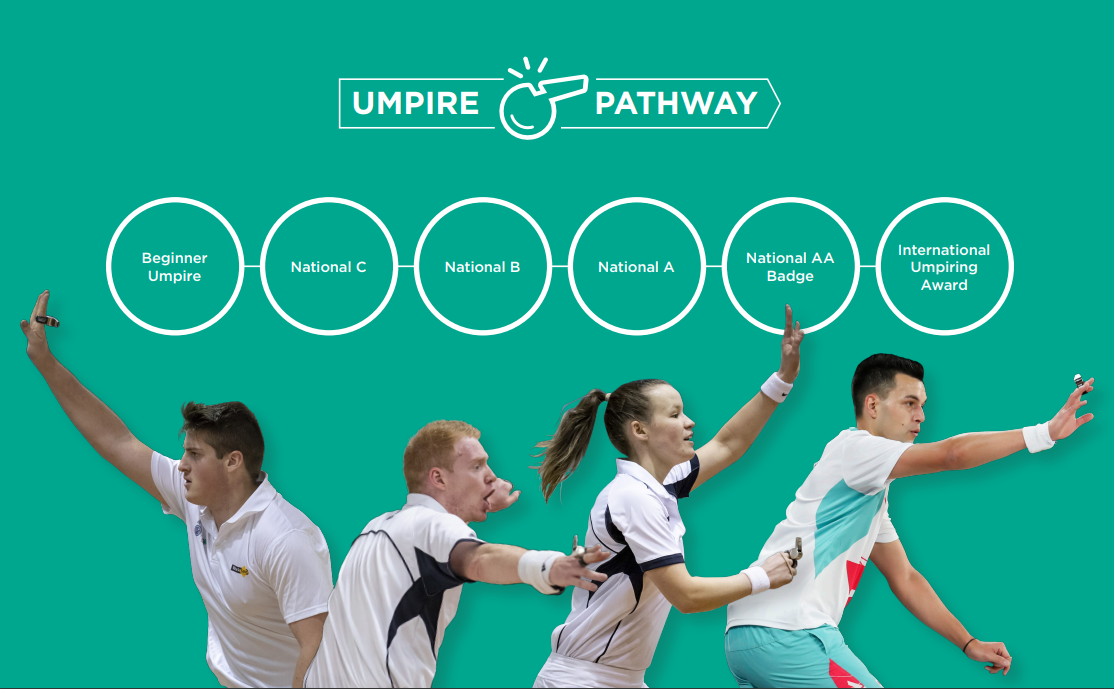
Umpire Accreditation Pathway
The Netball Australia Umpire Accreditation System is an educational pathway based on NA Umpiring Courses (Foundation, Intermediate and Elite), the Australian Sports Community Officiating Essential Skills course, ongoing professional development and practical umpiring instruction through an experienced umpire coach/mentoring system. Assessment is based on an appropriate pass mark of the Rules of Netball Theory Examination, practical evaluation through established competencies, self-reflection, coach feedback and, where possible, video analysis. The culmination of this accreditation system leads to practical assessment in a 4-tiered National system of badges: C, B, A, and the highest national award the AA (All Australia).
Umpire Accreditation Pathway & Badge Levels
Pre-requisites:
- Current Netball Victoria membership.
- Foundation Umpire Course (completed within the last 4 years)
- Rules of Netball exam (minimum 70% pass mark and completed within the last 4 years)
Practical Assessment:
- Local Game (Women's, Men's*)
- 4 x 10, 12 or 15 minute quarter game
- Netball Victoria affiliated competition
Summary of Competencies:
- Basic game management to keep game moving and maintain player safety to average standard matches.
- Basic procedural competence (late arrivals, failure to take the court, stoppages).
- Basic positioning and vision skills.
- Reactions/timing appropriate for low to average standard matches.
- Usually recognises and penalises obvious infringements, both major and minor.
- Applies “advantage goal” so as not to disadvantage non-offending team.
Pre-requisites:
- Current Netball Victoria membership.
- Intermediate Umpire Course (completed within the last 4 years)
- Rules of Netball exam (minimum 80% pass mark & completed within the last 4 years)
Practical Assessment:
- Local Game (Women's, Men's*)
- 4 x 15 minute quarter game
- Netball Victoria affiliated competition
Summary of Competencies:
- Intermediate knowledge of game management and implementation of procedures.
- Some understanding of when measures need to be taken to keep game safe (for example, overt unsportsmanlike conduct or dangerous play).
- Positioning and vision are not restricted to the immediate area where the ball is or the bulk of players are, to consider what is happening behind and ahead of play. This requirement is matched by the requirement that the candidate demonstrate basic advantage skills.
- More consistent recognition of minor infringements and more refined understanding (footwork, played ball for example).
- Obstruction: beginning to understand implications of rule beyond simple 0.9m defence (jump and land, standing within 0.9m and interfering with throwing/shooting action); beginning to recognise use of arms to limit movement of player without ball; obvious defending out of court.
- Contact: beginning to go beyond obvious examples of interference to distinguishing fair contest from contact (understanding body movements, including recognizing when a player or players cause an opponent to interfere).
- Advantage: vision skills allow some recognition of context of play and some assessment of what is of advantage to the non-offending team
Pre-requisites:
- Current Netball Victoria membership.
- Elite Umpire Course (completed within the last 4 years)
- Rules of Netball exam (minimum 90% pass mark & completed within the last 4 years)
Practical Assessment:
State League Game – 4 x 15 minute quarters
Summary of Competencies:
- Detailed understanding and application of all aspects of game management, including foul play and the actions that may be taken by umpires.
- There is an expectation that positioning, vision and timing will be guided by play and informed by an understanding of the game context. General principles are consistently executed, including adapting positioning and vision to specific circumstances to secure best view of play.
- This in turn allows a more refined application of the Advantage Rule, which allows the game to flow without losing control or undermining the standards set for game management.
- Rule interpretations demonstrate an understanding of the rule, an attention to detail and a common sense application in the game context.
- There should be a high level of consistency across both minor and major infringements. In particular:
- Obstruction: consistently penalises all forms of 0.9m defence across court areas; consistently recognises obstruction of player without the ball
- Contact: consistently distinguishes between contact and contest (again, allowing the game to flow without losing control or undermining game management); accurately identifies and penalises causing contact and inevitable contact.
Pre-requisites:
- Current Netball Victoria membership.
- A Badge Umpire Accreditation
- Elite Umpire Course (completed within the last 4 years)
- Rules of Netball exam (minimum 95% pass mark & completed within the last 4 years)
Practical Assessment:
- State League Game
- 4 x 15 minute quarters
Summary of Competencies:
- **The AA badge is an elite umpiring qualification reserved for candidates who display the highest levels of technical proficiency, rule understanding and game management. The AA Badge is the badge of excellence.
- Complete understanding of all aspects of game management which allows necessary procedures to be implemented promptly and professionally when they are required; good judgement and 'game sense' to ensure that the available actions are used at the right time and for the right purpose.
- Positioning, vision and timing work together to be in the best place at the right time, even when this is counter intuitive. The umpire reads play to adapt to different paces, patterns, and styles of play with minimal disruption to timing and decision-making.
- High level of decisional accuracy across major and minor infringements; makes decisions quickly and precisely; and applies them efficiently. Shows ability to prioritize correctly when multiple infringements occur.
- Demonstrates consistency and expertise in application of the Contact and Advantage Rule to enhance the contest and allow skilled play to occur, while maintaining control and ensuring that no team is unduly disadvantaged
Beginner Umpire
Association or League.
National C Badge
C Grade Development Camp, Association & League Games.
National B Badge
Victorian Netball League, Netball Victoria’s Talented Umpires Program, Netball Victoria’s High Performance Squad, Inter Academy Weekend, Association & League games.
National A Badge
National Tournaments, Australian Netball League, Victorian Netball League & Netball Australia’s Emerging Talent Squad.
National AA Badge
Suncorp Super Netball, Australian Netball League, Victorian Netball League & Netball Australia’s High Performance Umpire Program.
International Umpiring Award
Commonwealth Games, Netball World Cup, INF Appointments & Suncorp Super Netball.
C Badge
Pre-requisites:
Current Netball Victoria membership.
Current Foundation Umpire Education Course.
Current Rules of Netball exam (minimum 70% pass mark).
Practical Assessment:
Local Game – 4 x 10, 12, or 15 minute quarters
- Basic game management in order to keep game moving and maintain player safety in low to average standard matches
- Basic procedural competence (late arrivals, failure to take the court, stoppages). Basic positioning and vision skills.
- Reactions/timing appropriate for low to average standard matches.
- Usually recognises and penalises obvious infringements, both major and minor.
- Applies “advantage goal” so as not to disadvantage non-offending team.
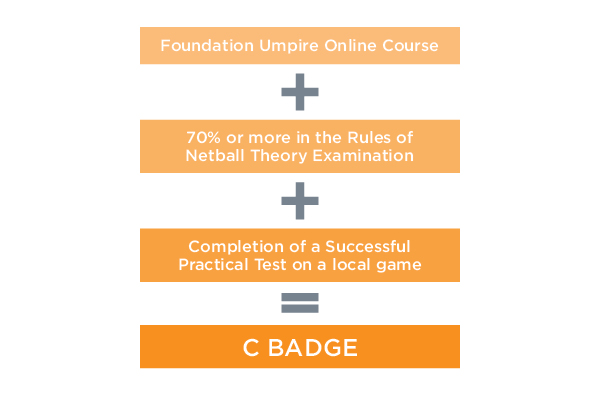
B Badge
Pre-requisites:
Current Netball Victoria membership.
Current C Badge accreditation OR current Foundation Umpire Education Course completion.
Current Rules of Netball exam (minimum 80% pass mark).
Practical Test:
Local Game – 4 x 15 minute quarters
- Sound game management and implementation of procedures.
- Some understanding of when measures need to be taken to keep game safe (for example, overt unsportsmanlike conduct or dangerous play)
- Positioning and vision are not restricted to the immediate area where the ball is or the bulk of players are, to take into account what is happening behind and ahead of play. This requirement is matched by the requirement that the candidate demonstrate basic advantage skills
- More consistent recognition of minor infringements and more refined understanding (footwork, played ball for example).
- Obstruction: beginning to understand implications of rule beyond simple 0.9m defence (jump and land, standing within 0.9m and interfering with throwing/shooting action); beginning to recognise use of arms to limit movement of player without ball; obvious defending out of court.
- Contact: beginning to go beyond obvious examples of interference to distinguishing fair contest from contact (understanding body movements, including recognizing when a player or players cause an opponent to interfere).
- Advantage: vision skills allow some recognition of context of play and some assessment of what is of advantage to the non-offending team.
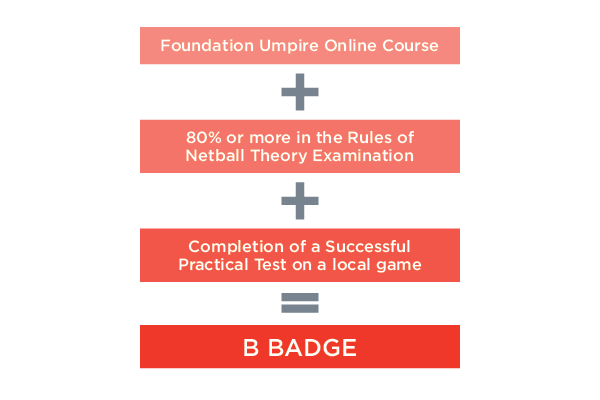
A Badge
Pre-requisites:
Current Netball Victoria membership.
Current Elite Umpire Education Course completion.
Current Rules of Netball exam (minimum 90% pass mark).
Practical Test:
Victorian Netball League game – 4 x 15 minute quarters
- Detailed understanding and application of all aspects of game management, including foul play (13.2) and the actions that may be taken by umpires (13.1, 13.3).
- There is an expectation that positioning, vision and timing will be guided by play and informed by an understanding of the game context. General principles are consistently executed, including adapting positioning and vision to specific circumstances to secure best view of play.
- This in turn allows a more refined application of the Advantage Rule, which allows the game to flow without losing control or undermining the standards set for game management.
- Rule interpretations demonstrate an understanding of the rule, an attention to detail and a common-sense application in the game context.
- There should be a high level of consistency across both minor and major infringements. In particular:
- Obstruction: consistently penalises all forms of 0.9m defence across court areas; consistently recognises obstruction of player without the ball; consistently identifies defending by a player who is out of court.
- Contact: consistently distinguishes between contact and contest (again, allowing the game to flow without losing control or undermining game management); accurately identifies and penalises causing contact and inevitable contact cognition of context of play and some assessment of what is of advantage to the non-offending team.
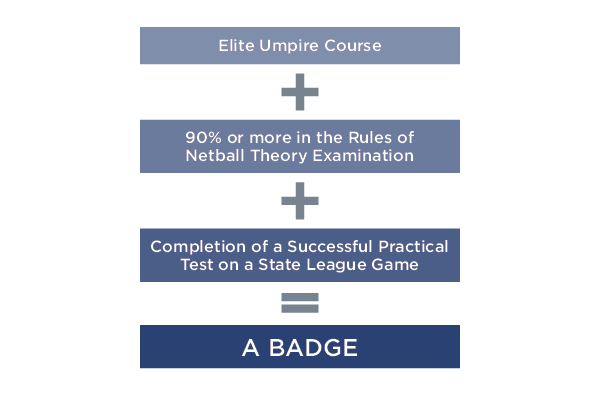
AA Badge
**The AA badge should not be seen as a “natural progression” from the A badge. It is an elite umpiring qualification reserved for candidates who display the highest levels of technical proficiency, rule understanding and game management.
- Complete understanding of all aspects of game management which allows necessary procedures to be implemented promptly and professionally when they are required; good judgment and “game sense” to ensure that the available actions are used at the right time and for the right purpose.
- Positioning, vision and timing work together to be in the best place at the right time, even when this is counter-intuitive. The umpire reads play to adapt to different paces, patterns and styles of play with minimal disruption to timing and decision-making.
- High level of decisional accuracy across major and minor infringements: makes decisions quickly and precisely, and applies them efficiently. Shows ability to prioritize correctly when multiple infringements occur.
- Demonstrates particular consistency and expertise in application of the Contact and Advantage Rule to enhance the contest and allow skilled play to occur, while maintaining control and ensuring that no team is unduly disadvantaged.
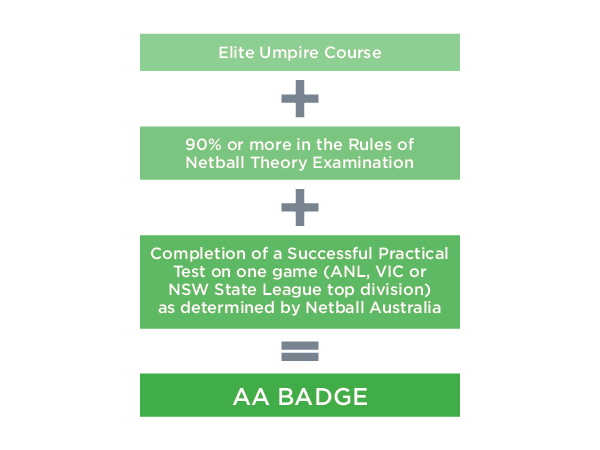
Please direct all enquiries to:Workforce

